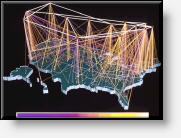 An ITU document entitled “Beyond Internet Governance”1 crossed my desk earlier this week. Given that I had absolutely nothing better to do, I decided to give it a read.
An ITU document entitled “Beyond Internet Governance”1 crossed my desk earlier this week. Given that I had absolutely nothing better to do, I decided to give it a read.
The audacity of the ITU Secretariat is nothing less than shocking.
It has been a long while since I read such a self-serving, narrow-minded and inaccurate document.
The backbone of the ITU’s contention rests on the premise that something called the Next Generation Network and the contention that this network will act as one big bug fix for all the problems created by current inter-networking technology.
“More recently, substantial standards and resource investment are being made by all major operators and equipment manufacturers in what is referred to as Next Generation Networks (NGN). NGN can be seen as a logical progression from separate PSTN- and IP-networks to a unified telecommunications network for electronic communications based on IP.”
The ITU is under the impression that their involvement in overseeing global Telecommunications infrastructure entitles them to some stake in managing the internet. They see embracing next generation development as a way to make this happen. After all, if they have a central role in the development this network, it only stands to reason that they are the best qualified to manage it.
Unfortunately, this misses a key point. In order to be a competent manager, basic qualifications must be met. In this case, these qualifications include developing a basic understanding of precisely what is being managed. The definition put forward by the ITU clearly demonstrates how completely they’ve missed the mark.
The internet works because there are clear separations between transport technology, interconnection technology and application technology. The ITU version of this blurs these boundaries and takes us a step backwards into a centrally controlled, centrally managed, “more than good enough” network – administered, of course, by the ITU.
This level of control and coordination is precisely what the internet successfully avoided. This is why the internet is successful. The internet works because it is almost trivial to interconnect heterogeneous networks in a near seamless manner, and by extension, every single other inter-connected network on the planet. It doesn’t matter what the transport mechansim looks like – GSM, PSTN, smoke signals, pigeons – all of these can be used as the basis for an IP-enabled network.
Let’s not forget what the internet actually is – a combination of privately and publicly owned (mostly private nowadays) and independantly controlled networks that interconnect using a common protocol. Inherent in this is a big implication that sometimes gets taken for granted, but nonetheless represents the foundation of the internet:
The network at your place of business belongs to your company. The network at the library belongs to the library. The network in my house *IS MY NETWORK*. These are my wires, my machines and my rules and they don’t need to be centrally coordinated, converged or subject to same vague benefits that I might get from your notion of quality of service.
The phone company, and therefore the ITU, is in the business of interconnect – moving bits from my network to yours – because the PSTN and associated telco interconnects provide the most convenient form of interconnect. But this doesn’t mean that they own those interconnects, or by extension, control of the internet because of the distinction between the transport, data, interconnect and application layers.
 Let
me rephrase – the only reason that the phone company is involved in the
business of interconnect is because a customer, like me or you, has
requested that they provide us with the physical infrastructure
necessary to implement the interconnection. In most cases, when they
screw this up, there are other choices available that does not include
the telco, and by extension the ITU. Radio, satellite, microwave, cable
- there are a multitude of almost perfect substitutes that we can avail
ourselves of.
Let
me rephrase – the only reason that the phone company is involved in the
business of interconnect is because a customer, like me or you, has
requested that they provide us with the physical infrastructure
necessary to implement the interconnection. In most cases, when they
screw this up, there are other choices available that does not include
the telco, and by extension the ITU. Radio, satellite, microwave, cable
- there are a multitude of almost perfect substitutes that we can avail
ourselves of.
But back to my point. The ITU aspires to a network management and oversight role. Thus far, the ITU has really only been involved, tangentially, in the business of managing interconnects. They seek to expand this role by exerting influence over the development of what they characterize as NGNs in a transparent ploy to claim management rights over this NGN.
The problem is, NGNs are anything but “…a logical progression from separate PSTN- and IP-networks to a unified telecommunications network for electronic communications based on IP.” In fact, the notion of the NGN as conceived by the ITU runs completely contrary to what made the internet successful in the first place. This is much less than a technical evolution and most certainly a power grab of epic proportions. The ITU is playing very dangerous games with a very precious resource.
Convergence of the PSTN and the IP networks is patently ridiculous and unsupported by current market dynamics. Convergence to the degree implied by the ITU eliminates transport indepedance. This is a patently dangerous notion. Most disappointing, the logic used to justify this power-grab is borderline silly.
Take this for example – “…growing infrastructure vulnerabilities, fraud, spam, phishing, security flaws, and cybercrime, will lead to a slow steady decline and dwindling confidence in the medium by users, unless they are addressed vigourously and rapidly. ...one of the significant drivers of the extensive standardization work on NGN is dealing with some of these public infrastructure vulnerabilities.”
In and of itself, this truth of this statement is self-evident. Mom and apple pie that no one disagrees with. After all, who doesn’t want to do something about spam, phishing and all of these other ills. But take a closer look at the underlying message.
The fundamental design of the internet is flawed and we can fix it.
If you let us fix it, we will create a perfect environment for you in which no one will be able to do wrong.
No more spam, no more phishing, no more intellectual property infringement.
 This
pronouncement comes to you from the same organization that oversees
that world telecommunications infrastructure. The same infrastructure
that facilitates billions of dollars of fraud per year. The same
infrastructure that allows international thieves to skim up to 3% of each cellular carriers revenue every day. The same infrastructure that helps boiler room fraudsters bilk millions from unsuspecting seniors. The same infrastructure that makes it easy for a con artist to re-route my modem calls to Moldova at the cost of dozens of dollars per minute!
This
pronouncement comes to you from the same organization that oversees
that world telecommunications infrastructure. The same infrastructure
that facilitates billions of dollars of fraud per year. The same
infrastructure that allows international thieves to skim up to 3% of each cellular carriers revenue every day. The same infrastructure that helps boiler room fraudsters bilk millions from unsuspecting seniors. The same infrastructure that makes it easy for a con artist to re-route my modem calls to Moldova at the cost of dozens of dollars per minute!
This pronouncement is a threat, made by the ITU, that represents a clear and present danger to the sovereignty and autonomy of this union of networks. A threat that must be dealt with quickly and decisively. Next Generation Networks, as defined by the ITU, are anything but NGNs - they are not the natural successor to the current generation of internetworking technologies. They are not an excuse to take a second crack at building your information superhighway.
The NGN is a fascist vision of a centrally managed fix for precisely what isn’t broken.
1 For an organization that likes to fly the "inclusiveness" and "digital divide" banners so prominently, they produce far too many documents in proprietary formats that require hundreds of dollars of software to decode and read. Its too bad that this is precisely the type of service that we can look forward to on their NGN.



